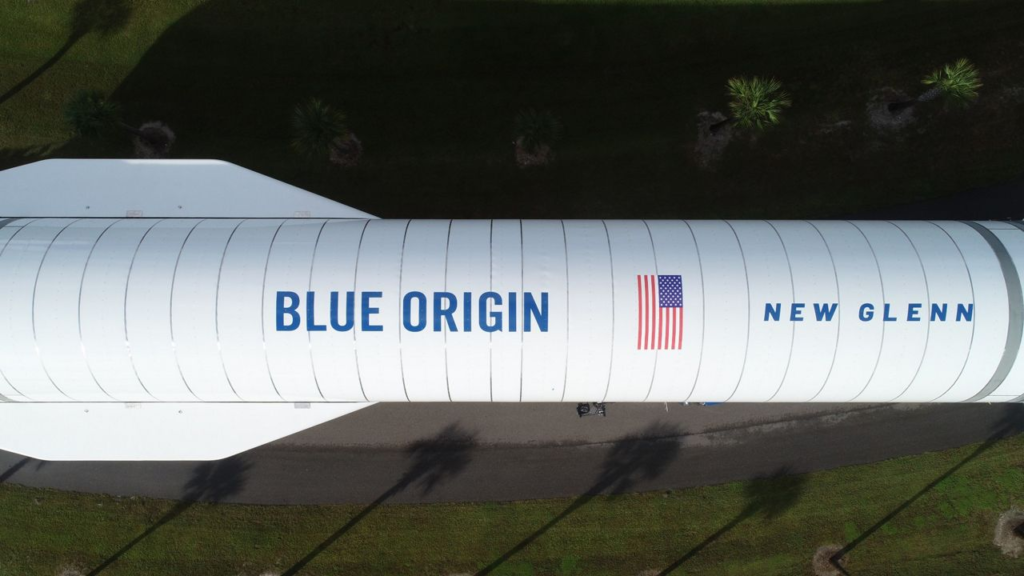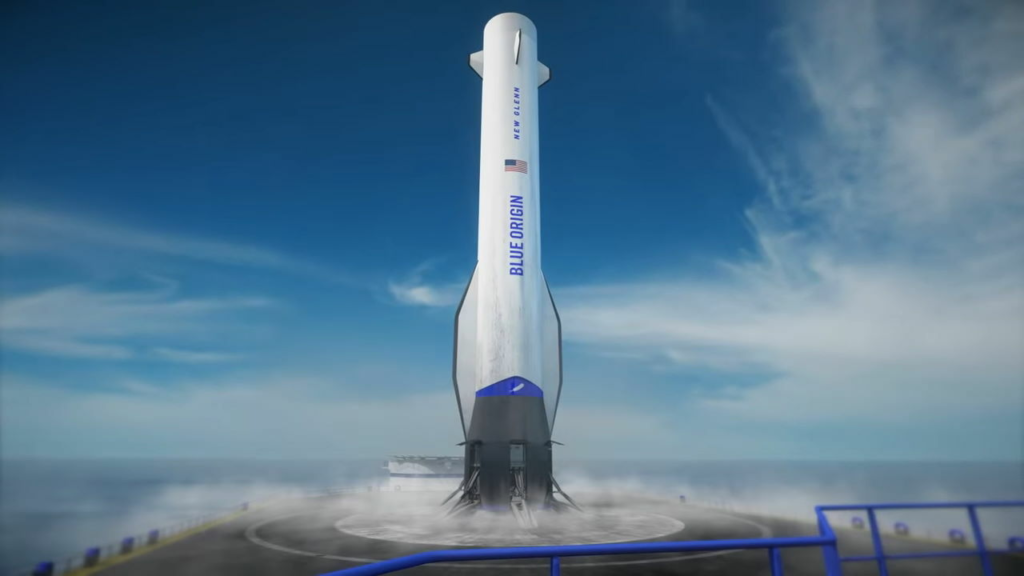
Will New Glenn Launch In 2024?
Blue Origin was founded around the same time as SpaceX but has taken a very different path than the other company. They decided to start small and with a launch vehicle meant for missions to the edge of space. This gave them an opportunity to learn about engine development, crew safety, and propulsive landings, just to name a few.
While even New Shepard has recently run into a few issues, the company’s primary goal for a long time now has been New Glenn. This partially reusable heavy-lift launch vehicle is an ambitious step up from the small suborbital rocket but it’s the path Blue Origin decided to take. As of right now, the company is still targeting 2024 for the first launch of this rocket.
Even though Blue Origin is not very transparent and keeps the majority of developments to themselves, this seems extremely ambitious, or is it? Here I will go more in-depth into the company’s progress, the 2024 launch date, what to expect in the coming months, and more.
Is 2024 Possible?

For a while now Blue Origin hasn’t necessarily been revealing dates or even a specific year for the first flight of New Glenn. One of the ways we know they are targeting 2024 was a recent contract from NASA. Specifically, earlier this year, the agency announced that Blue Origin was awarded a task order to provide launch service for the agency’s Escape and Plasma Acceleration and Dynamics Explorers (ESCAPADE) mission, a part of the VADR contracts. This launch is scheduled to take place in 2024.
This being said, it’s important to point out that VADR provides FAA-licensed commercial launch services for payloads that can tolerate higher risk. In a statement, the agency said, “By using a lower level of mission assurance, and commercial best practices for launching rockets, these highly flexible contracts help broaden access to space through lower launch costs.” In other words, it’s not a huge deal if deadlines are missed or even if payloads are lost. In this case, it would suggest that both the company and agency are not the most confident in Blue Origin’s ability to be ready for a New Glenn Mars mission next year. To add to the pressure, The principal investigator for ESCAPADE Rob Lillis of the University of California Berkeley’s Space Science Laboratory said in a quote that ” the current launch window for the mission is Aug. 6 through the 15 of 2024.” With July only days away this would mean in just over a year the rocket would need to be ready.
While all these factors and comments go against Blue Origin and New Glenn’s future launch schedule, there are a few pieces of evidence in the rocket’s favor. For example, the principal investigator for the mission is confident New Glenn will be ready. In a quote, he said, “It hasn’t launched yet and we are concerned about that. But, having seen the Blue Origin facility at Cape Canaveral, I was much less concerned after seeing all the work they’ve done. I’m confident they will likely be ready for the launch of ESCAPADE” he said. While this is by no means clear evidence that Blue Origin will be ready, it’s a very interesting comment from someone with much more information than the general public.
Since NASA selected New Glenn to launch ESCAPADE, he said he’s had 15 meetings with Blue Origin and that “They’ve been very responsive.” He also confirmed the $20 million price for the New Glenn, which is “massively oversized” for ESCAPADE. “It’s a new company trying to get into the market,” he said “They were able to bid what they knew the price was going to be, regardless of the cost to them.”
This mission will see New Glenn lift off with two identical small spacecraft, which will provide simultaneous two-point observations. After payload deployment, it will take ESCAPADE about 11 months to arrive at Mars after leaving Earth’s orbit, where both spacecraft will spend several months adjusting their orbits before they are in position to best capture data about the magnetosphere. Even though its considered a higher-risk mission, NASA along with other companies involved are expecting both capable and high-quality hardware for the launch.
A Lot of Work Left

Over the past few months, we have seen snippets of progress from Blue Origin with the majority of work being done behind the scenes. Days ago a new Temporary Flight Restriction and a Marine Safety Information Bulletin were published in relation to Blue Origin. It looks like the company will be attempting fairing recovery operations between the 27th and the 30th of this month. Back in January earlier this year the company did the exact same thing.
Around one week ago we even saw Blue Origin’s Transporter Erector go vertical at the pad. This system will raise New Glenn from horizontal to vertical in preparation for testing and eventually launch. It’s obvious from these various hints that work is being done but the exact state of the program is still unknown.
Arguably the most significant update out of all of these was the recent static fire of Vulcan’s first stage. This booster uses two BE-4 engines in conjunction with optional Solid Rocket Boosters to launch the heavy-lift rocket. Ever since these two engines were delivered they have been performing very well in practically all tests. New Glenn will use 7 of these engines on its first stage which will generate (3.85 million lbf) thrust at sea level. Unfortunately for both New Glenn and Vulcan, the first use of these engines in flight is going to have to wait at least a few months. Vulcan’s upper stage ran into some issues and needs to be de-stacked and returned to the factory. This means the launch won’t happen until at least late this year or even early 2024.
The flight data from these engines is going to be extremely valuable to New Glenn whether the results are good or bad. Since these engines have never actually flown, until Vulcan gets off the ground Blue Origin wont have that data.
Out of every component on New Glenn, the BE-4 engines play one of the most important roles both for launch and reuse. The engine was designed from to be a medium-performing version of a high-performance architecture. An engine capable of much higher performance that doesn’t quite use all of its potential. They did this to try and lower development risk while meeting performance, schedule, and reusability requirements. The engine uses LNG because its highly efficient, low cost, and widely available. LNG also possesses clean combustion characteristics even at low throttle, simplifying engine reuse compared to kerosene fuels. An important factor for a rocket hoping to reuse 7 of these engines every launch.
In terms of progress, we have seen a significant ramp up in engine production which is a good sign. New videos from Blue Origin show factories full of BE-4 engine components as they manufacture more engines. With Vulcan using two per launch and not reusing them and New Glenn needing 7 per rocket, the BE-4 engine will be high in demand.
Focusing back on the company and work toward the maiden flight, there are still a lot of unknowns related to the future plan and New Glenn. Information became public in July 2021 that Blue Origin had begun a “project to develop a fully reusable upper stage for New Glenn,” under the name “Project Jarvis”. Beyond the technical changes indicated, Bezos created a new management structure for the new efforts, walling off “parts of the second-stage development program from the rest of Blue Origin, telling its leaders to innovate in an environment unfettered by rigorous management and paperwork processes. However, no indication of the budget allowed to the development of this reusable second-stage was released to the public. Since then, we have seen more images of test tanks popping up which brings up a lot of questions.
There also are big unknowns related to the first stage reuse method. The first stage boosters of New Glenn are intended to be reusable, and were originally intended to be recovered downrange on the Atlantic Ocean via their landing platform ship Jacklyn, which would have acted as a floating movable landing platform. The hydrodynamically stabilized ship was intended to increase the likelihood of successful recovery in rough seas. This was up until the company scrapped Jacklyn, and then sold it for scrap. Soon after reports came out that Blue Origin had contracted the same exact company as SpaceX to create large autonomous drone ships for booster recovery. We haven’t heard anything since related to booster reuse and landing platforms. Years ago, on Blue Origin’s website, they showed the New Glenn flight profile and the landing platform as a ship. Now the updated version is simply a low profile platform. It’s also possible that for the first fight, Blue Origin expends the booster or attempts a controlled landing and splashdown in the ocean.
In the future, New Glenn’s fully reusable first stage is designed for a minimum of 25 flights. The company is hoping that Civil, commercial and national security customers can all find solutions in New Glenn’s configuration. On a normal mission, New Glenn lifts off from Launch Complex 36 at Cape Canaveral. Following stage separation, the first stage flies back to Earth and lands nearly 1,000 km downrange on a platform. The second stage engines ignite and the 7-meter fairing separates. The mission is complete when the payload is delivered safely to orbit.
Conclusion
Blue Origin is continuing to work on New Glenn for an ambitious 2024 launch date. Between then and know a decent amount of work is still needed. We will have to wait and see how it progresses and the impact it has on the space industry.
